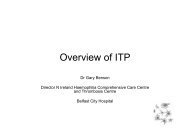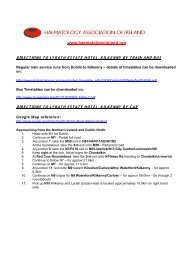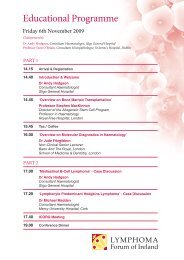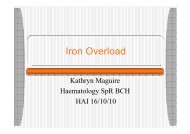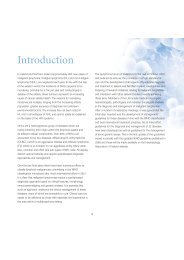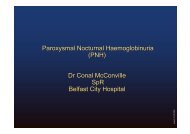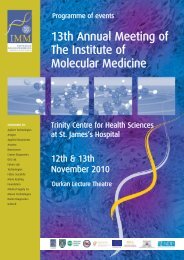Guidelines on Diagnosis and Treatment of Malignant Lymphomas
Guidelines on Diagnosis and Treatment of Malignant Lymphomas
Guidelines on Diagnosis and Treatment of Malignant Lymphomas
Create successful ePaper yourself
Turn your PDF publications into a flip-book with our unique Google optimized e-Paper software.
Stage 1 (bulky) <strong>and</strong> stages II – IV<br />
R-CHOP for 6-8 cycles. The decisi<strong>on</strong> in low or low-intermediate<br />
risk IPI patients is based <strong>on</strong> giving 2 cycles bey<strong>on</strong>d achievement<br />
<strong>of</strong> complete resp<strong>on</strong>se. Those with high-intermediate or high IPI<br />
scores should have maximum treatment. Accelerated R-CHOP at<br />
14 day intervals with G-CSF for 6 cycles may be equally effective.<br />
C<strong>on</strong>solidati<strong>on</strong> radiati<strong>on</strong> to sites <strong>of</strong> bulky disease should be<br />
c<strong>on</strong>sidered. The OS at 5 years <strong>of</strong> 65% remains sub-optimal <strong>and</strong><br />
approaches such as the NCI-sp<strong>on</strong>sored DA-R-EPOCH using<br />
infusi<strong>on</strong>al chemotherapy appears to result in a higher OS <strong>of</strong> 73%<br />
<strong>and</strong> PFS <strong>of</strong> 70% at 5 years. Prognostic factor adjusted<br />
chemotherapy in DLBCL has not yet been adopted in a uniform<br />
fashi<strong>on</strong>, though it is clearly an area <strong>of</strong> critical importance.<br />
Resp<strong>on</strong>se Evaluati<strong>on</strong><br />
Resp<strong>on</strong>se should be evaluated every two cycles <strong>of</strong> treatment,<br />
with radiological evaluati<strong>on</strong> after 4 cycles <strong>and</strong> at the end <strong>of</strong><br />
treatment. Infiltrati<strong>on</strong> <strong>of</strong> marrow or CSF at diagnosis, needs to be<br />
rechecked at the end <strong>of</strong> treatment. Patients who are not in PET<br />
negative CR at the end <strong>of</strong> treatment have primary refractory<br />
disease <strong>and</strong> should be c<strong>on</strong>sidered for salvage therapy.<br />
Follow up<br />
Clinical: History <strong>and</strong> physical examinati<strong>on</strong> every 3 m<strong>on</strong>ths for<br />
2 years, every 6 m<strong>on</strong>ths for 3 years <strong>and</strong> then yearly with particular<br />
attenti<strong>on</strong> to sec<strong>on</strong>d malignancies.<br />
Relapsed or Resistant DLBCL<br />
Patients with primary refractory disease may not need to be<br />
re-biopsied before initiating salvage therapy, but all patients<br />
with relapsed disease should be re-biopsied. Assessment <strong>and</strong><br />
staging is the same as in newly-diagnosed disease. The total<br />
anthracycline dose must be assessed if they are to be used in<br />
salvage therapy <strong>and</strong> a pre-treatment ECHO is advised.<br />
<strong>Treatment</strong>: In patients



